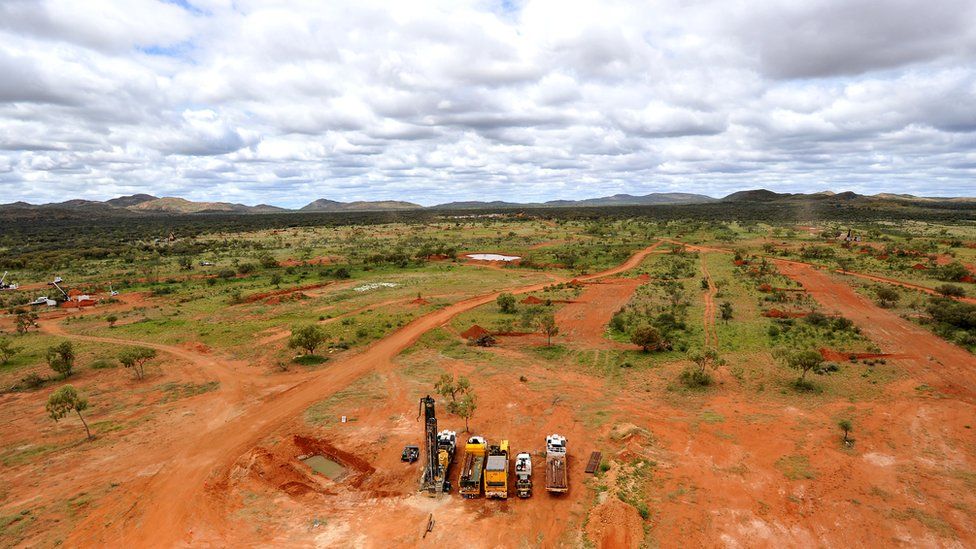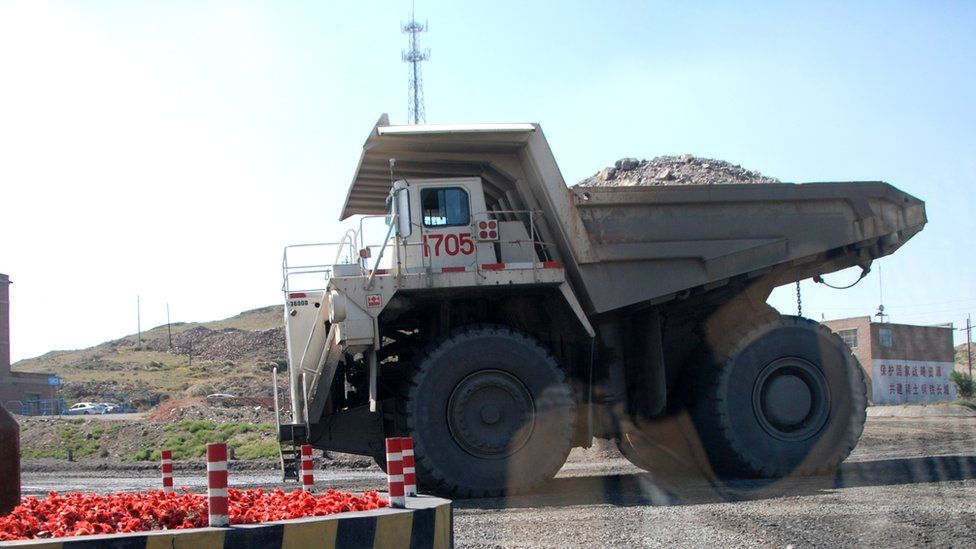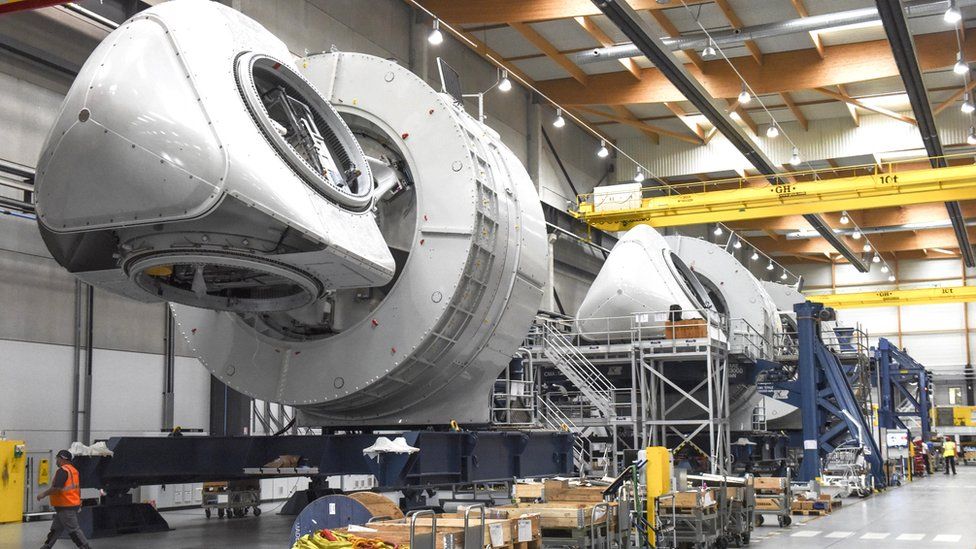Australia challenges China in mining for essential elements

In the blood red dust of central Australia, mining firm Arafura is planning to build a mine and processing facility for highly sought-after elements.
Located 80 miles north of Alice Springs, the Nolans Project will be in one of the hottest and driest parts of the country.
Despite the extreme conditions, Arafura believes the investment will be worth it. The planned mine and processing facility could satisfy up to 5% of global demand for neodymium and praseodymium (NdPr), which are used in high-power magnets.
They are two of a group of so-called rare earth elements, that are essential to the electronics industry.
NdPr, europium, terbium and other rare earth metals that were once barely heard of are now commonplace in the manufacture of phone touchscreens, wind turbines and other modern technologies.
The mining of these minerals is an industry currently dominated by China, but geopolitical and trade forces are at work that could reshape the international market.

Australia, a superpower exporter of iron ore and coal with rich mining traditions believes it is well-placed to join the race to exploit minerals that provide critical parts for electric vehicles and wind turbines.
“This could certainly be a game-changer for Australia. We are relatively well-endowed in rare earth elements,” says Gavin Lockyer, managing director of Arafura Resources.
“This could really put Australia front and centre in the renewable sector.
“It is relatively easy to discover a rare earths deposit. What is difficult is finding a deposit that has economic quantities of the valuable materials.”
Rare earths are a collection of more than a dozen elements on the periodic table. They are not particularly rare, but actually fairly plentiful in the Earth’s crust.
Geoscience Australia, a government research agency, says they have broad industrial, medical, domestic and strategic applications “because of their unique catalytic, nuclear, electrical, magnetic and luminescent properties”.
They are used in “magnets and super magnets, motors, metal alloys, electronic and computing equipment, batteries, catalytic converters, petroleum refining, medical imaging and lasers”.
Europium is found in fluorescent lighting, gadolinium in nuclear power rods and ytterbium in solar panels.

Mr Lockyer points out that some of the latest technology relies on their properties.
“It is important to note that an electric vehicle might only have AUD$200 (£120; $140) or so of NdPr in it, but without it that electric vehicle will not work efficiently. Similarly with the wind turbines,” he adds.
In a time of war and menace, the valuable metals have strategic value and are used in fighter jets, guided missiles and drones along with other high-tech equipment for space exploration.
Australian firm Lynas Rare Earths has been contracted by the United States Department of Defense to build a multimillion-dollar processing facility in the US in a bid to reduce its reliance on China for strategic minerals.
Lynas is the world’s only significant rare earths producer outside China and runs the Mount Weld mine in Western Australia.
“We look forward to not only meeting the rare earth needs of the US government, but also reinvigorating the local rare earths market,” Lynas managing director Amanda Lacaze told the Australian Broadcasting Corp.

The US Energy Secretary Jennifer Granholm warned recently at a conference in Sydney that China was “big-footing” renewable energy technology and supply chains.
Beijing’s control of the supply of rare earths has been documented by the Australian Strategic Policy Institute (Aspi), an independent think tank based in Canberra.
It noted how the minerals have become weapons of diplomacy following a 2010 collision between a Chinese fisherman and Japanese patrol boats near a disputed chain of islands. Beijing complained about the “illegal interception” of its trawlers and retaliated.
“We saw the Chinese government stop rare earth supply to Japan as part of its economic coercion against the Japanese government,” says Aspi analyst Albert Zhang.
“Since then, what countries have noticed is that there is a risk by having only one major supplier of rare earths [and] such an essential raw material isn’t beholden to just the political will of one government. Australia has the materials and the right sort of companies and capital investment to diversify the world’s supply chain.”
Australian experts have said that more recently China threatened to limit rare earth shipments to American defence contractors because of US arms sales to Taiwan.

John Coyne, who is in charge of Aspi’s Northern Australia Strategic Policy Centre, also warns that China will not easily surrender its vice-like dominance of the international rare earths sector. He alleges that Beijing uses its “power and market-distortion tactics to strategically flood the market when it wants to drive out competitors and deter new market entrants”.
“Australia has the world’s sixth-largest reserves of rare earth minerals. However, they remain largely untapped with only two mines producing them,” he says.
“There is significant potential in the establishment of multi-ore mineral-processing hubs in Australia. After all, there is no point in creating supply chain resilience for [rare earth] ores if miners must still send them to China for processing.”
China’s Global Times said Beijing would welcome “benign competition” to “improve production capacity” in the industry.
The newspaper added that “the US and some of its allies, in their pernicious and selfish attempt to contain China’s rise, has brought toxic geopolitics to the crucial rare earth industry as well as other economic and trade fields”.


Earlier this year, the South Korean carmaker Hyundai signed a memorandum of understanding with Arafura Resources, which provides “them security of supply [of rare earths] in a geopolitically stable environment”.
A similar agreement to supply NdPr was reached between Arafura and GE Renewable Energy in July.
“What we have all seen during the pandemic is the importance of having multiple supply chains,” says GE’s Sam Maresh. “Ultimately, it is in everyone’s interest to have diverse supply chains.
“We require rare earths to make very, very strong magnets that are used in our offshore wind turbines. NdPr allows you to make magnets that are super-strong [that] allow for the rotation and for the turbine to generate electricity using the wind,” he told the BBC.
“We know that the energy transition requires a lot of rare earths. We use about 600kg of super-magnets for every offshore wind turbine. So we need a lot of this product. We can’t decarbonise without rare earths.”
